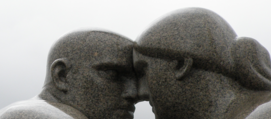This is a heavily redacted prophesy about the end of the book and the coming of machine-mediated brain-to-brain communication I wrote in February 1993 to Kali Tal as part of a longer exchange about hallucinogenic drugs, the coming of mind-to-mind communication through VR, and other things.
Bumpercar enhanced empaths
Tools are human.
There are no technologies without humanities.
Artificial intelligence is a metaphor for the psyche. (And not much more, believe me.) Just as the idea of a psyche is a contraption of cognitive psychology and philosophy, and the brain is a concoction of neurology, so is AI just an idea of what it wants human intelligence to be. (A machine.)
Multimedia, even as virtual reality, is a metaphor for the sensorium, a perceptual gadget beholden to poetics and media studies. It’s got a wonderful future, but it’s just a stab in the dark theater of our desire to be more intimate and stimulating.
Nothing is yet quicker than the light of the slow word.
Yes, we are in the late age of print. What we whiff now is not the smell of ink but the smell of loss, of burning towers or men smoking cigars in the drawing room, thinking they are building an empire. Hurry up please, it’s time. Yes, the time of the book has passed. But it will persist to give glorious pleasure, like other obsolete forms that continually renew themselves and the soul: the poem, dance, graffiti. The book is dead, long live the book.
We will continue to read from paper just as we continue to write poems and tell stories. Or put bannisters in elevators. Yeah, like that’s gonna help you if that cable snaps. The persistence of obsolete forms, attached to the idea of the material thing called a book, which is after all just one of many technologies for delivering the word that began with scrawls on clay and stone. Think of the book as a metaphor for the process it inscribes, for getting one’s solo thoughts into many other heads, one at a time. Just one of many technologies we’ve devised to get what’s in my brain into yours and vice versa. Tech-mediated-telepathy. TMT.
When Sony debuted Discman, a portable, mini-CD the size of a Walkman, capable of holding 100,000 pages of text, a discussion on the Gutenberg listserv complained with pain, with nostos algia, wistful pain for home: “The smell of ink … the crinkle of pages…”
“But you can’t read it in bed,” she said, everyone’s last redoubt, the last-ditch argument. As if it was lovemaking. It was lovemaking. As if.
Meanwhile in far-off laboratories of what Stuart Moulthrop calls the “Military-Infotainment Complex” at Warner, Disney or IBApple and MicroLotus, a group of scientists work on synchronous smell-o-vision with real time simulated fragrance degradation shifting from fresh ink to old mold. Another group builds raised-text flexible touch screens with laterally facing windows that look and turn like pages, crinkling and sighing as they exfoliate.
“But the dog can’t eat it,” someone protests. Smiling silently, the techies go back to their laboratories with bags of silicon kibbles.
Swimming across this undertow to save ourselves from being swept away, tilting at this windmill, we should keep alive the idea of what the book was and can be, Don Quixote. Tristram Shandy. Gravity’s Rainbow.
In an age when people buy and do not read more books than have ever been published before, perhaps we will each become like the living books of Truffaut’s version of Bradbury’s Fahrenheit 451, vestal readers walking along meandering rivers of light just beyond the city of text. We face their task now, resisting what flattens us, re-embodying reading as movement, as an action rather than a thing, appropriating the metaphor that we think will diminish what we love. Silently scanning with and absorbing meanings in the mind. Becoming. We should view the book as a network, a node in a network, each word an implicit hypertextual link to archeologcal layers of meaning rendered by what has already been written elsewhere. Always already been and being written.
And as we appropriate the term for the electronically mediated telepathic future we should also resolve to colonize the territory, invade it, dominate it. The network is ours to inhabit. Imperial booty. We will read there. Read minds.
But how?
Think of what we yet need to do to get VR to work, I mean really work: a map of how cognitive modes function in the neurophysiology of the brain that then can be mimicked by a dumb ole binary machine, even a massively interconnected one … with *enhancements*, baby, quantum mechanical implants in the brain.
As we get better and better at doing that, we’re gonna achieve some pretty good turnaround time in transcribing thoughts into evanescent images beyond words. We will produce other sensory kinesthetics (I should say performances). The time between upload and download shrinks, the kinesthetic performances become better and better at representing what’s in our heads, especially since the gear is our heads, and pretty soon you get telepathy, or tech-mediated telepathy, its asymptote.
Now amp up the part of the brain that integrates connections into feelings of transcendence – is it the dorsal raphe nucleus? — with a pattern that does something like Ecstasy or MDMA –forced massive sudden depletion of the serotonin reserves, so the big whoosh comes flooding down (or up) from the brainstem, and you get your waterbed bumpercar enhanced empath … Holy shit there’s more here than I thought. You just did it to me, that miracle, the intrusion of another world into thus one, transcendence at the interface.
I think I know what YOU MEAN.









You must be logged in to post a comment.